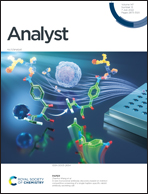A plasmon resonance-inspired discriminator unscrambles lipoprotein subtypes†
Abstract
Cardiovascular diseases are strongly linked to circulating lipoprotein subtypes. However, the significance of their discrimination is generally underappreciated. Herein, we designed a facile approach for efficacious and precise profiling identification of lipoprotein subtypes inspired by the plasmon resonance of gold nanorods (AuNRs). With the addition of an anti-low density lipoprotein (LDL) aptamer, the discriminator platform realized accurate identification of lipoprotein subclasses (LDL, high density lipoprotein (HDL), and very low density lipoprotein (VLDL)). Subtle differences in the structures and physicochemical properties of lipoproteins result in distinct spectral signatures, which provide a unique “chemical fingerprint” for each target. The identifier offered a straightforward approach for the semi-quantitative profiling of lipoprotein subtypes in human serum. Oxidized LDL (Ox-LDL), one of the earliest incidents in atherosclerosis, could also be identified from the lipoprotein subtypes. Furthermore, 14 proteins including LDL, HDL, VLDL, and Ox-LDL were precisely distinguished by linear discriminant analysis (LDA) via establishing a two-dimensional sensor array. More importantly, the discriminator facilitated the distinction of lipoproteins in clinical serum samples from healthy and hypercholesterolaemic patients.



 Please wait while we load your content...
Please wait while we load your content...